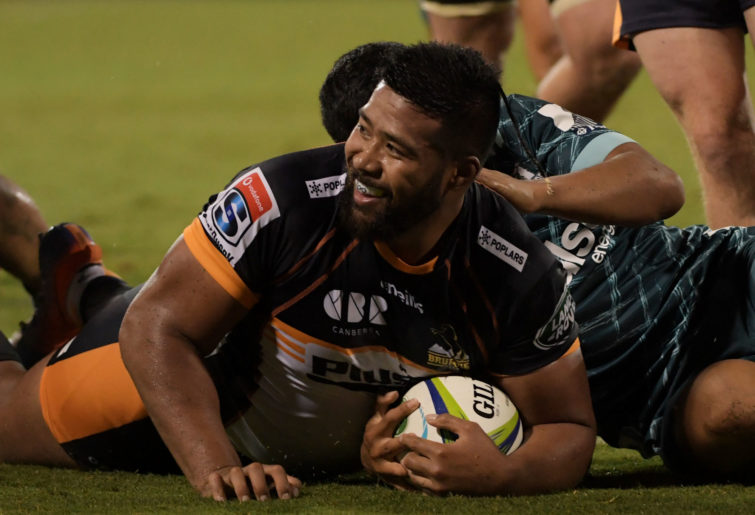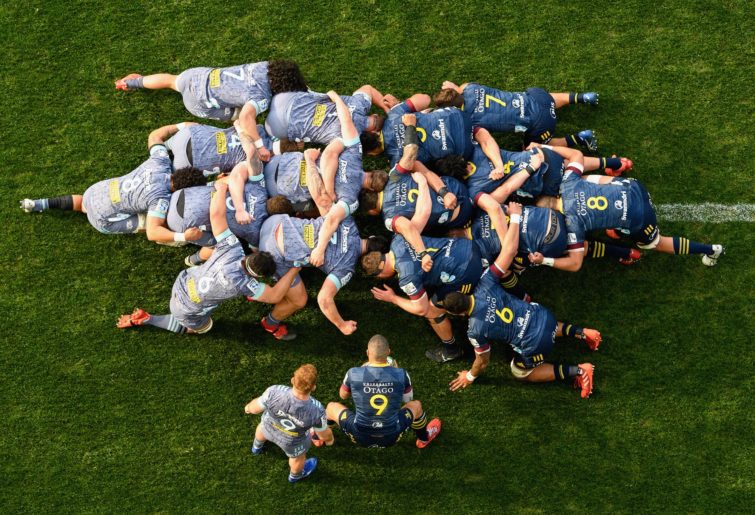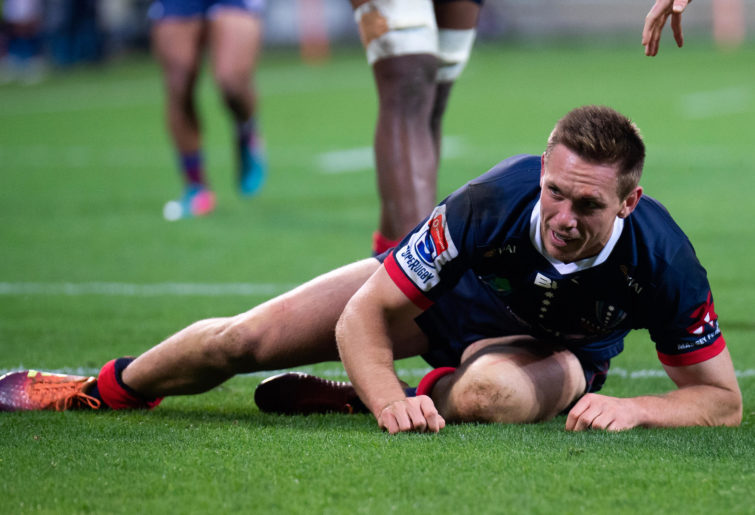One of the benefits of playing Test rugby in December and starting Super Rugby in mid-February is that the ‘silly season’ is kept mercifully short.
That didn’t prevent some eyebrow-raising moments surfacing over the break, including Rugby Australia chairman Hamish McLennan using his casting vote to determine that the 2021 Wallabies will strip in a version of the classic 1991 jersey.
Of itself that wasn’t a bad decision at all, but the accompanying rationale – that McLennan chose the 91 jersey because it was the clear favourite of the 13,000 fans polled – raises possibilities. For example, will those same fans get to vote on whether the Wallabies take three points in Test matches when they are on offer?
The launch of the New Zealand franchise ‘away jerseys’ was a revelation, with an Adidas spokesperson suggesting that the Hurricanes design “plots the locations of wind turbines in the club’s local area on top of a pattern inspired by shifting sands”, while the Crusaders jersey “begins with the backbone of our region – the mighty Southern Alps”.
“From these mountains, the source of our strength, flow ancient glaciers, and our jersey features a pattern inspired by this glacial ice, reflecting both our legacy and our unstoppable momentum,” the spokesperson said.
Here was I thinking that the success of the Crusaders was down to consistently smart recruitment and player development, continuity and the coaching prowess of Scott Robertson and his assistants. How foolish.
Now that the secret’s out, don’t be surprised to see glacier-blessed West Coast climb from the lower reaches of Heartland rugby to the top of the Mitre 10 Premiership in 2021.
Chaos and confusion reigned last week with Rugby Australia’s confirmation of law variations for the 2021 competition. At a press hook-up to announce and explain the changes all was going well until one particularly annoying rugby writer raised the anomaly that the ‘super time golden try’ law, as it was written, would potentially allow for a side to win a match despite having scored fewer points than the opposition.
Despite the obvious well-meaning intent and purpose, was Australian rugby ready for the ridicule that would surely be hurled its way by mainstream media and other sports?
Another pow-wow with the franchise coaches was hastily arranged and a clarification was provided the next day, where it was then confirmed that the only form of scoring permissible in ‘super time’ is a try to end the contest.
This has all the ingredients of being one of those situations where the ‘solution’ is worse than the original problem. In one camp are the many who don’t understand why a draw, a perfectly valid result, has found itself included among the targets of cancel culturists.
For others open to the idea of super time, there is unease that a match can be won with a drop goal or penalty goal in the 80th minute but not in the 82nd minute.
With defenders able to push the envelope in super time knowing that penalties conceded won’t be punished by a goal, expect to see teams kick to the corner. Which begs the question: is another line-out maul try really a more exciting way to decide a match than watching Reece Hodge have a pop at goal from 60 metres?
On one level the willingness of the coaches to play a leading role in adding excitement to the game is admirable. On another this move entrenches the belief that Australian rugby and ‘taking the three’ are uncomfortable bedfellows.

(Photo by Tracey Nearmy/Getty Images)
That there is a fresh feeling of anticipation about the new season is in large part due to the reinvigoration that comes with a new broadcast partner. The launch of Stan/Nine’s rugby coverage had enthusiasm and excitement stamped all over it, and Nick McArdle and Roz Kelly are inspired choices to head up the coverage.
There were teething issues to be sure. Nine’s own website buried the launch of their new commentary team deep in their sports tab, below a rehashed account of how US golfer Patrick Reed might not be the most popular guy on tour. Hardly groundbreaking news.
On the plus side, Drew Mitchell found himself on the Today show and, despite the familiar and predictable white-anting that has started up again in sections of the News Corp press, rugby in Australia is about to rediscover the benefit of having a free-to-air television presence.
Importantly, there have been assurances made that the scope of match-day production will return to the levels more usually associated with a major sport, thus avoiding the ridiculous situation of last season where budget cuts implemented by Fox Sports meant that referees were pointlessly sending decisions upstairs to television match officials who had no behind-the-goal vision from which to rule.
As if that wasn’t enough to put a spring in the step of referee’s boss Scott Young, he also indicated during the press briefing that referees will be focusing diligently on applying time limits to the setting of scrums and the clearing of the ball from rucks. Promising.
This year, perhaps more than usual, it will be critical for coaches to get a handle on how these and other key areas like the breakdown will be refereed and to shape their game plans accordingly. Between the franchises there is fertile ground to be won and lost.

(Photo by Kai Schwoerer/Getty Images)
The main factor that will determine Super Rugby AU, however, is the incidence of injury and more specifically which players in which teams get injured and can be adequately covered from within each squad.
Another way of looking at it is that a case can be made for all of the franchises to qualify for the finals based on their best one to 15. Beyond that, from players 16 to 35, things become spottier.
There are big-name casualties already, with Liam Wright, Tom Wright and Dane Haylett-Petty set to miss significant chunks of the competition. Angus Scott-Young has been touted as a suitable replacement for Liam Wright, but even if he measures up, the Reds already feel skinny there, and that’s before we start talking about replacing their skipper.
The Rebels are in a similar boat with Haylett-Petty. Matt To’omua is a ready replacement at skipper, but as experienced a utility as Reece Hodge is, he can’t play multiple positions at once. With Hodge an obvious contender to cover fullback until Haylett-Petty returns, centre Campbell Magnay’s recovery from injury takes on a different light and places an immediate spotlight on Melbourne Storm recruit Young Tonumaipea.
The pressure on young big men like Nick Frost, Trevor Hosea, Ryan McAuley, Tuania Taii Tualima and Sam Caird will be immense. For all of them the days of being considered ‘promising’ are already over. All will carry a significant load and be required to take the next step if their side is to make progress in the competition.
For some coaches it is either feast or famine. The Force’s Tim Sampson will be challenged balancing proven Test performer Tomas Cubelli and his captain, Ian Pryor, at halfback. Sampson has quality and experience studded through his backline but less so across his loose forwards.
The message is clear. All sides will lose players. It is all about which areas you lose them.

Dane Haylett-Petty
doesn’t know when he’ll play again (Photo by Speed Media/Icon Sportswire via Getty Images)
What happens to the Reds, for example, if they lose Taniela Tupou for any extended period of time? Plenty, I’d suggest, and none of it good. What happens to the Waratahs’ prospects if Will Harrison is forced out?
Young flyhalf Carter Gordon looks to be a promising recruit, but Rebels fans will be beside themselves if To’omua is injured. With Will Miller and Lachie McCaffrey gone from the Brumbies back row and Rob Valetini sporting an injury-prone history, do the Brumbies have sufficient ball-winning capacity at the breakdown?
Over in Perth there is high anticipation surrounding Puma’s flyhalf, Domingo Miotti. Behind him, however, is a group of players who are either near the end of their career or who haven’t quite measured up to this level in the past.
It all makes for a fascinating proposition, complicated even further on Friday when the whole Rebels squad was forced to flee Melbourne and drive in their own cars to Canberra to escape sudden lockdown.
For the sake of the squad and their families – not to mention a Rebels organisation desperate for some home-field action – and of the equity of the competition, it must be hoped that this latest round of restrictions is lifted quickly.
Given the nature of the virus and the track record of the Victorian state government, that’s not a prediction that can be made with any confidence. About as little confidence as can be applied to predicting the outcome of this competition.
At face value the Reds are well placed to go one step further. The Brumbies, relative to other franchises, have an advantage around squad continuity and a winning culture. The Force have made big strides in recruitment and will benefit from playing at home this time around.
The Rebels feel like a middle-of-the-table side that could tip up or down, while the Waratahs, albeit with a number of promising developing players, appear to have the shallowest list.
All of that is before the impact of injuries begins to kick in. That’s the unknown factor and that’s why this Super Rugby AU competition is totally up for grabs.































































































